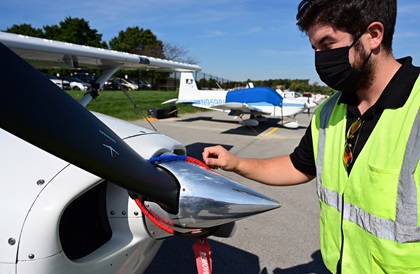Flying in the Washington, DC, FRZ
Three airports require special attention
My assignment to cover the inaugural Latinas in Aviation Global Festival at the College Park Aviation Museum had an additional twist: Bust out my previously unused personal identification number (PIN) that allowed me to land at College Park Airport inside the Washington, D.C., Flight Restricted Zone (FRZ)—one of the “Maryland Three” airports requiring a completed security course, fingerprinting, and a background check.
However, a bit of extra planning for flying in this area is essential. Because AOPA headquarters at Frederick Municipal Airport in Maryland is close to the Washington, D.C., Special Flight Rules Area (SFRA), I’d previously completed the online safety course required for flying within 60 nautical miles of the DCA VOR.
The FRZ security course was administered by Beechcraft Bonanza pilot and Hyde Field/Washington Executive Airpark Airport Manager Coordinator Stan Fetter who helped craft some of the rules during a monthslong give-and-take with the Transportation Security Administration (TSA) and the FAA after the terrorist acts of September 11, 2001. Pilots will recall that in the days following the attacks, massive flight restrictions were implemented throughout the national airspace system, which effectively shut down all aviation except for military, law enforcement, and emergency-related aircraft operations.
Through AOPA regulatory staff’s dogged determination, GA missions gradually increased, though additional security measures were made a permanent part of the flying landscape. In February 2005, an interim final rule transferred responsibility for ground security procedures at the Maryland Three Airports (sometimes called the DC-3 airports) from the FAA to the TSA. The FAA issued a revised notam for the Washington, D.C., area, allowing vetted transient pilots to operate in the FRZ airspace.
It never hurts to ask a local pilot about flying in the area, so as a pre-FRZ backstop I huddled with AOPA Flying Clubs Initiative Manager Drew Myers, a Free State Flying Club member based at College Park Airport, for details. “Since I earned my pilot certificate, most of my flying has been out of airports based in the SFRA, so I’m used to it,” he said. “Once you hook up with an instructor and do it live, it all makes sense.” Myers looked over my intended flight plan a few days in advance and then we reviewed the FRZ procedures together. A final test included Myers role-playing a flight service specialist for this newbie and it helped tremendously.
I began the journey from Frederick Municipal Airport to College Park Airport by filing a FRZ flight plan through an app, then I called 703-771-3476 and dictated my PIN. I was a little worried about all that, but it turned out to be easier than expected. Helpful flight service personnel updated the IFR flight plan I accidentally filed and changed it to the correct DC VFR flight plan with an entry at the Wooly Gate. A final check of notams didn’t indicate anything unusual, and I was on my way.
So, on a glorious fall morning I piloted a Cessna 172 through some of the most restricted airspace in the United States with confidence. Shortly after takeoff I was handed off to Potomac approach, communicated my FRZ flight plan out of Frederick, dialed in the assigned squawk code, and threaded the VFR corridor between Baltimore/Washington International Thurgood Marshall Airport and Ronald Reagan Washington National Airport.
I had entered the Washington, D.C., SFRA from the north and overflew about 30 miles of rolling hills, ponds, and subdivisions until I spotted the University of Maryland’s stocky tan-and-white buildings and green athletic fields just to the west of my route. The airfield was at my 12 o’clock so I called air traffic control to advise that College Park was in sight, still feeling a bit apprehensive about my first FRZ landing.
“Cessna One-Six-Three-Mike-Echo, change to the local advisory frequency and remain on the assigned transponder code until on the ground,” air traffic control chirped into my headset. I acknowledged. Next, I reduced power, made the local radio call, and entered the pattern for the 2,600-foot-long Runway 15/33. Trees framing the runway kept me on guard but not as much as the desire to perform an uneventful landing for a growing audience gathered to welcome the groundbreaking Hispanic female aviators.

A propeller lock was secured around the Skyhawk’s nose soon after I taxied to the ramp and shut down. College Park Airport Manager Lee Sommer assured me it was standard operating procedure for the Maryland Three. He said a heavy-duty vinyl-covered motorcycle or bicycle cable with a lock would do the trick if I wanted to bring my own next time. I noted the handful of airplanes dotting the ramp were also secured by similar devices.
The Latinas in Aviation Global Festival recognized the pioneering women who made their mark in aviation, and it was a very upbeat event. After the last stories were shared, it was time to make my way north after gaining permission to takeoff and exit the FRZ.
Departing the area requires a phone call on the ground (not a radio transmission) to Potomac Tracon Clearance Delivery after filing a DC FRZ flight plan. I called 866-599-3874, stated my N-number, that I was at College Park Airport, and requested clearance for a return to Frederick Municipal Airport. I was assigned a different squawk code and told to check in with Potomac Departure after takeoff, which I did.
Heading northwest, I was vigilant about remaining under the Class B airspace and VFR flight following helped me spot traffic inside the SFRA until I exited. An uneventful flight, a smooth landing at my home base in Frederick, Maryland, and the security of knowing I had another tool in my flying belt gave me the confidence to try flying in the FRZ again sometime soon.








